Microsoft Power Platform Developer (PL-400) Practice Exam New Available
Easily passing the PL-400 exam is not delusional. Find the exact PL-400 dumps and make sure you have enough time to take the Microsoft PL-400 practice exam, and success is a piece of cake. It is not difficult to succeed on the first attempt. From this sentence, you know how important the practice exam is to pass the Microsoft Power Platform Developer.
With the help of the PL-400 practice exam, a shortcut to Microsoft PL-400 certification is provided: https://www.pass4itsure.com/pl-400.html

Use the PL-400 practice exam to identify your knowledge gaps and consolidate the concepts you already know:
QUESTION 1 #
You are researching integrations with several external systems.
Each integration has different requirements.
You need to determine which data sources to use to meet each requirement.
What should you use? To answer, drag the appropriate data sources to the correct requirements. Each data source may be used once, more than once, or not at all. You may need to drag the split bar between panes or scroll to view content.
NOTE: Each correct selection is worth one point.
Select and Place:
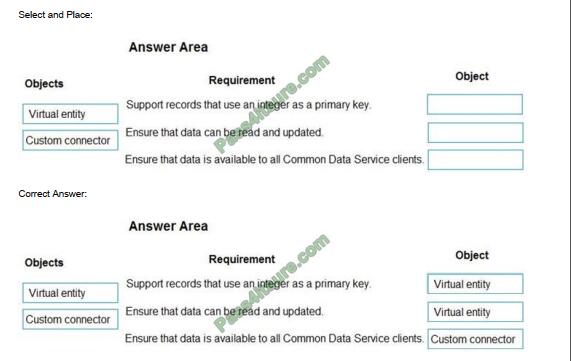
Box 1: Virtual entity
Initially, defining a virtual entity is the same as defining a custom entity: you specify the entity, attributes, and relationships for the new virtual entity type.
You can use GUIDs as primary keys in the external data source.
Box 2: Virtual entity
Virtual entities enable the integration of data residing in external systems by seamlessly representing that data as entities in Microsoft Dataverse (Common Data Service), without replication of data and often without custom coding.
Virtual entities support to create, update and deletion of data in the external system.
Box 3: Custom connector
A custom connector is a wrapper around a REST API (Logic Apps also supports SOAP APIs) that allows Logic Apps,
Power Automate, or Power Apps to communicate with that REST or SOAP API.
QUESTION 2 #
A company has a model-driven app that captures applications from prospective students.
You are asked to create a new re-usable custom component using the Power Apps component framework (PCF).
The custom component must allow entry of date of birth and validate that the applicant is not a minor.
You create the class AuditDatePicker in the TypeScript file Index.ts and the style sheet DatePicker.css.
You need to define the component to be available only for relevant fields and its properties when used in a form.
How should you complete the manifest? To answer, select the appropriate options in the answer area.
NOTE: Each correct selection is worth one point.
Hot Area:
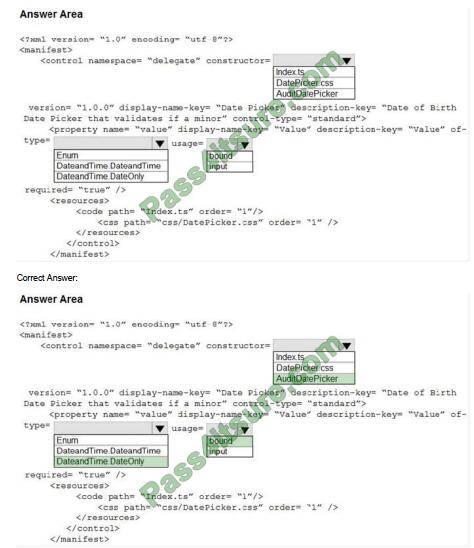
Box 1: AuditDatePicker
Constructor: Constructor of the code component.
Box 2:DateandTime.DateOnly Box 3: bound usage: Has two properties, bound and input. Bound properties are bound only to the value of the field. Input properties are either bound to a field or allow a static value.
QUESTION 3 #
You are creating an integration that uses an Azure function to create records in the Common Data Service when leads are submitted from your company website.
You create and configure a Common Data Service application user.
You do not have administrator access to the Common Data Service environment you are using for access to Azure Active Directory.
Company policy dictates that service accounts must be used for integrations, and integrations must not be granted privileges beyond what is needed.
You need to recommend actions that an administrator should perform to configure access for the Azure Function.
Which three actions should you perform? Each correct selection presents part of the solution.
NOTE: Each correct selection is worth one point.
A. Create an application registration in Azure Active Directory.
B. Assign the system administrator security role to the application user.
C. Assign the Power Platform administrator role to the application user in Azure Active Directory.
D. Create a new security role with the minimum required permissions and assign it to the application user.
E. Grant the application delegated permissions to the Dynamics CRM API in Azure Active Directory.
F. Deploy Azure B2B guest permissions to the application user.
Correct Answer: ADE
QUESTION 4 #
An organization implements Dynamics 365 Sales.
You need to trigger a business rule when the main form in saved.
What should you do?
A. Write a business rule to trigger a change of modified field.
B. Set the scope of the business rule to one specific form where the business rule triggers.
C. Set the scope of the business rule to All Forms.
D. Set the scope of the business rule to Entity.
Correct Answer: D
Set the scope of the business rule to “Entity” instead of “All Form”. This will trigger it on the server-side.
QUESTION 5 #
A company uses SharePoint for its intranet and other functions. The company has also implemented model-driven apps.
SharePoint users must be able to create contact records in the Common Data Service (CDS), without having to navigate to the model-driven apps.
You need to create a link in SharePoint to open the CDS contact from displaying data from SharePoint.
How should you complete the URL? To answer, select the appropriate options in the answer area.
NOTE: Each correct selection is worth one point.
Hot Area:
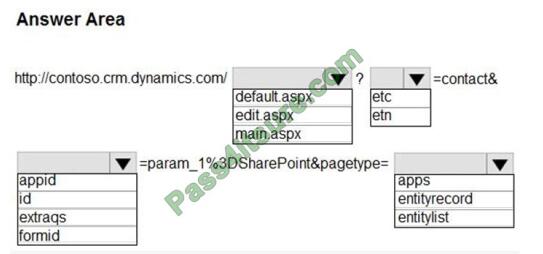
Correct Answer:
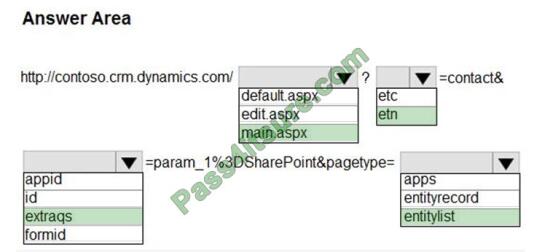
Box 1: main.aspx
Example, to open the Active Contacts view.
https://myorg.crm.dynamics.com/main.aspx?etn=contactandpagetype=entitylistandviewid={00000000-0000-0000-00AA-
000010001004}
Box 2: etn
In: The logical name of the entity. Important: Do not use the etc (entity type code) parameter that contains an integer code for the entity. This integer code varies for custom entities in different organizations.
Box 3: Extras
Extras: Optional for forms. This parameter contains encoded parameters within this parameter. When you open a new form by using the URL address, you can include arguments in the extras parameter to set field values
Note: You must encode the parameters passed in the extras parameter. To encode the parameters, use encodeURIComponent. To use special characters like “=” or “and” in the parameter values, you must double encode (e.g. to set name to
A=BandC, it would be extraqs=name%3DA%253DB%2526C).
Box 4: entitylist
Page type: The type of page. There are two possible values:
-entity record
Displays an entity record form.
-entity list
Displays an entity view.
Reference: https://docs.microsoft.com/en-us/powerapps/developer/model-driven-apps/open-forms-views-dialogs-reportsurl
https://docs.microsoft.com/en-us/powerapps/developer/model-driven-apps/set-field-values-using-parameters-passedform
QUESTION 6 #
A company is creating a new system based on the Common Data Service (CDS).
You need to select the CDS features that meet the company\’s requirements.
Which features should you select? To answer, drag the appropriate features to the correct requirements.
Each feature may be used once, more than once, or not at all. You may need to drag the split bar between panes or scroll to view content.
NOTE: Each correct selection is worth one point.
Select and Place:
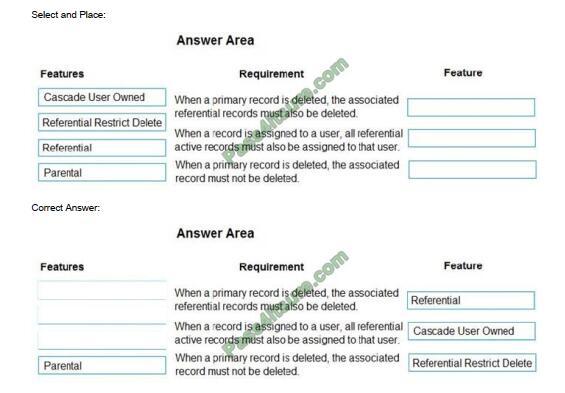
Box 1: Referential
Active/ Cascade Active one-to-many entity relationship: Perform the action on all active referencing entity records associated with the referenced entity record.
Box 2: Cascade User Owner
Cascade User Owned: Perform the action on all referencing entity records owned by the same user as the referenced entity record.
Box 3: Referential Restrict Delete
Restrict: Prevent the Referenced entity record from being deleted when referencing entities exist.
QUESTION 7 #
You are troubleshooting Power Apps solutions.
You need to determine the cause for the identified issues.
What is the root cause for each issue? To answer, select the appropriate options in the answer area.
NOTE: Each correct selection is worth one point.
Hot Area:
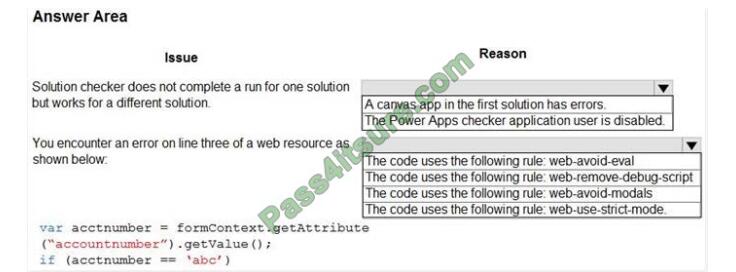
Correct Answer:
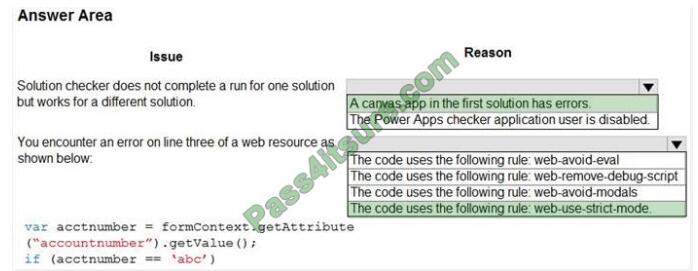
QUESTION 8 #
You are creating a model-driven app.
Users need to see only the entities in the app navigation that are relevant to their role and their method of accessing the app.
You need to restrict entities on the sub-areas in the SiteMap.
Which properties should you use? To answer, drag the appropriate properties to the correct requirements.
Each property may be used once, more than once, or not at all. You may need to drag the split bar between panes or scroll to view content.
NOTE: Each correct selection is worth one point.
Select and Place:
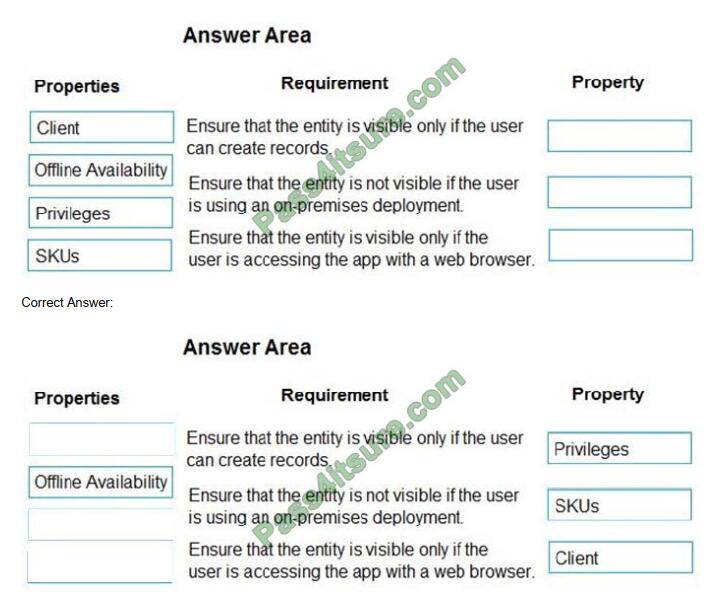
Box 1: Privileges
Privileges: This defines whether a subarea is displayed based on privileges available in any security roles that are assigned to the user.
Box 2: SKU
SKUs: Select the versions of Dynamics 365 that display this subarea.
Box 3: Client
Client: Select the type of client that displays this subarea.
Incorrect Answers:
Offline Availability: Select this check box to make this subarea available to users when they are offline in Dynamics 365 for Outlook.
Reference:
https://docs.microsoft.com/en-us/powerapps/maker/model-driven-apps/create-site-map-app
QUESTION 9 #
A company needs to illustrate the relationships of the entities in Dynamics 365 Sales.
You need to select the appropriate tool to show this graphic.
Which tool should you select?
A. Metadata diagram
B. Sales Insights
C. Power Automate
D. Security model
Correct Answer: A
Visual representation of metadata can be useful, especially when you are trying to describe the relationship between entities in the system. You can use the Metadata Diagram sample code provided for Dynamics 365 Customer Engagement (on-premises) to generate the entity-relationship diagrams.
You can create a diagram that shows a relationship for just one entity, or a complex diagram that includes dozens of related entities, including custom and system entities.
QUESTION 10 #
A company has a development environment and a production environment. The production environment has several third-party managed and unmanaged solutions that made changes to the Contact main form.
You create a new solution in the development environment. You add the Contact entity and the Contact main form to the solution. You create a custom field on the Contact entity.
What happens when you perform these actions and import the solution into the production environment?
To answer,
select the appropriate options in the answer area.
NOTE: Each correct selection is worth one point.
Hot Area:
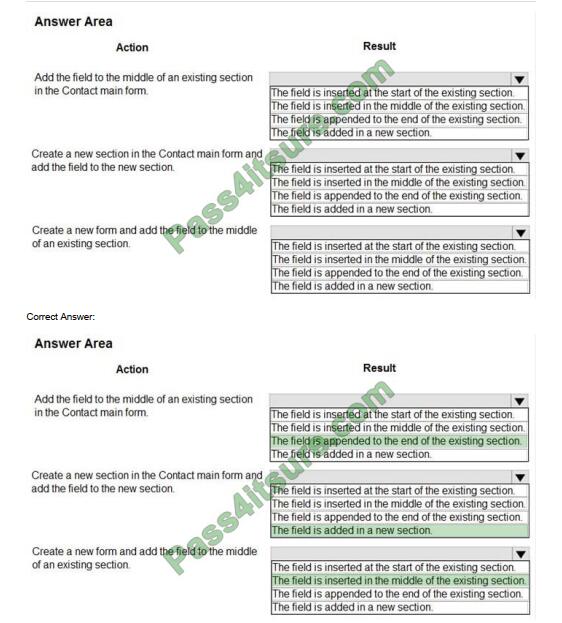
Box 1: The field is appended to the end of the existing section.
When you add new elements to a form that is to be merged, we recommend that you include your new elements within new container elements (tabs or sections). Additions to any container will be appended to the end of the container. For example, fields added to a section will be positioned at the end of the section.
Box 2: The field is added in a new section.
Box 3: The field is inserted in the middle of the existing section
QUESTION 11 #
HOTSPOT
You work for a multinational company that has an Azure and Common Data Service environment in the United States (UTC-7) and Japan (UTC+9).
You create Azure Functions for each location to update key data.
You need to configure the functions to run at 4:00 AM on weekdays at each location.
Which schedule formats should you use? To answer, select the appropriate options in the answer area.
NOTE: Each correct selection is worth one point.
Hot Area:
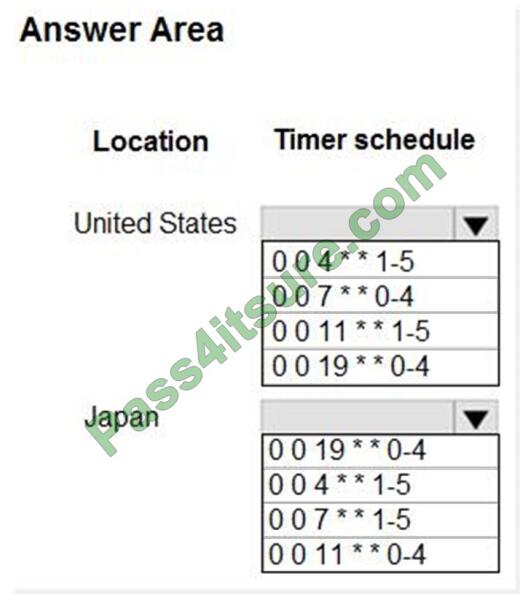
Correct Answer:
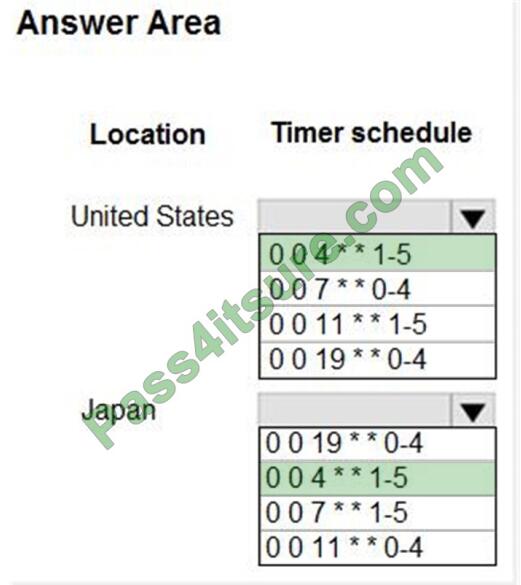
Box 1: 0 0 4 * * 1-5
Azure Functions uses the NCronTab library to interpret NCRONTAB expressions.
An NCRONTAB expression is similar to a CRON expression except that it includes an additional sixth field at the beginning to use for time precision in seconds:
{second} {minute} {hour} {day} {month} {day-of-week}
NCRONTAB time zones
The numbers in a CRON expression refer to a time and date, not a time span. For example, a 5 in the hour field refers
to 5:00 AM, not every 5 hours.
The default time zone used with the CRON expressions is Coordinated Universal Time (UTC).
To have your CRON expression based on another time zone, create an app setting for your function app named
WEBSITE_TIME_ZONE.
1-5 is weekdays
Box 2: 0 0 4 * * 1-5
Reference:
https://docs.microsoft.com/en-us/azure/azure-functions/functions-bindings-timer?
QUESTION 12 #
You need to handle errors in UpdateRecord.js. Which code segment should you add at line UR06?
A. catch(error) { alert(“Caught error: ” + error.message);}
B. Exception exception = Server.GetLastError() ; if(exception != null)}
C. catch(exception e){ console.writeline(e)}
D. function (error){ console.log(error.message)}
Correct Answer: A
The catch statement lets you handle the error. Syntax: catch(err) { Block of code to handle errors }
Reference: https://www.w3schools.com/js/js_errors.asp
QUESTION 13 #
DRAG-DROP
You are creating a business process flow for an organization\\’s Request for Quote process.
You need to ensure that the business process flow meets the company\\’s requirements.
Which components should you use?
To answer, drag the appropriate components to the correct requirements. Each component may be used once, more than once, or not at all. You may need to drag the split bar between panes to scroll to view content. Select the appropriate options in the answer area.
NOTE: Each correct selection is worth one point.
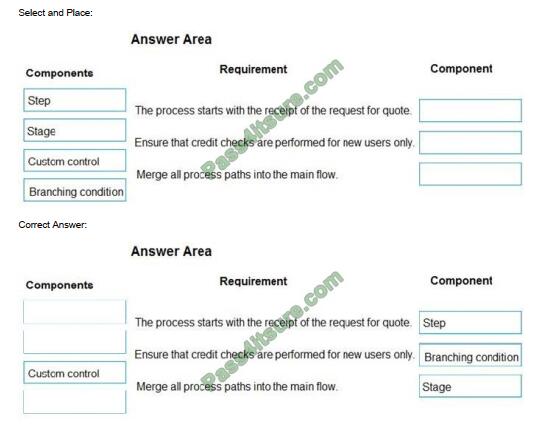
Box 1: Step
Each step represents a field where data can be entered.
Stages tell you where you are in the process, while steps are action items that lead to the desired outcome.
Box 2: Branching condition
You can enhance a business process flow with branching. If you have the create permissions on business process flows, you’ll be able to create business process flow with multiple branches by using the If-Else logic.
Box 3: Stage
Each stage contains a group of steps.
Incorrect Answers:
You can use custom controls to add rich visualizations (such as sliders, radial knobs, LinkedIn control, and more) to business process flow steps and deliver engaging experiences to those who use your business process.
Reference:
https://docs.microsoft.com/en-us/power-automate/business-process-flows-overview
https://docs.microsoft.com/en-us/power-automate/enhance-business-process-flows-branching
QUESTION 14 #
You need to determine the primary cause of the issue reported by interns when they use the app. What is the primary cause?
A. Interns have the System Customizer security role but need the Environment Maker security role.
B. Interns have the Common Data Service User security role but need the Environment Maker security role.
C. Interns have the Environment Maker security role but need the Common Data Service User security role.
D. Interns have the Environment Maker security role but need the System Customizer security role.
E. Interns have the Environment Maker security role but need the Delegate security role.
Correct Answer: D
Scenario: Interns can create apps but cannot interact with their own data.
Environment Maker role: Can create new resources associated with an environment, including apps, connections, custom APIs, gateways, and flows using Microsoft Power Automate. However, this role doesn\’t have any privileges to access
data within an environment.
System Customizer role: full permission to customize the environment. However, users with this role can only view records for environment entities that they create.
Reference:
https://docs.microsoft.com/en-us/power-platform/admin/database-security
QUESTION 15 #
You have a Common Data Service entity and a model-driven app. The model-driven app integrates with an external system.
You plan to run business logic each time the model-driven app creates a record. Running business logic must not negatively affect model-driven app users.
You need to implement the business logic.
What should you use?
A. Synchronous plug-in registered in the PreOperation stage
B. Synchronous workflow
C. Asynchronous plug-in registered in the PostOperation stage
Correct Answer: C
The asynchronous service executes long-running operations independent of the main Microsoft Dataverse core operation.
This results in improved overall system performance and improved scalability.
Reference: https://docs.microsoft.com/en-us/powerapps/developer/common-data-service/asynchronous-service
The PL-400 dumps pdf with Google Drive:
PL-400 exam pdf free practice exam https://drive.google.com/file/d/1V1PK3bsfWW14BkSt9qyRObPgysWmJUJv/view?usp=sharing
At last
Using the Pass4itSure PL-400 practice exam, you can easily master the PL-400 real exam and get Microsoft Power Platform Developer certification.
Not to be missed, https://www.pass4itsure.com/pl-400.html offers real questions and answers for the PL-400 exam to help students answer their questions in the best possible way.
